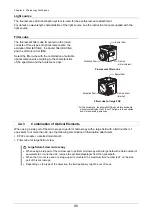
Chapter 4 Microscopy Techniques
83
4.2 Details of Phase Contrast (Ph) Microscopy
4.2.1 Principles of Ph Microscopy
Ph microscopy is a method of observing colorless,
transparent specimens such as living cells in an
unstained way using dia-illumination.
Objects that change the amplitude of light are called
amplitude objects (such as transparent objects, or
stained objects) and objects that change the phase
of light are called phase objects (such as colorless,
transparent specimens, or living cells). Ph
microscopy visualizes phase objects, which are
unrecognizable to the human eye.
Visualizing phase objects
The illumination that has reached the specimen is
divided into two types: direct light which is bright,
having passed non-phase objects, and diffracted
light which has passed phase objects. In case the
optical path difference between specimens is very
small, the phase of the diffracted light comes
approximately 1/4
λ
later than that of the direct light.
In Ph microscopy, the amplitude of the direct light is
alleviated with an ND filter, and at the same time, the
phase of the direct light is changed with a phase
plate by only 1/4
λ
. This operation causes the phase
contrast of the direct light to be 1/2
λ
or 0.
Interference between the direct light and optical path
allows you to observe the phase change as the
contrast of the light.
Ph microscopy optical system
The Ph microscopy optical system is shown in the
following figure.
The light emitted from the light source is annularly
narrowed by the annular diaphragm. It passes the
condenser lens, and then illuminates the specimen.
The illumination is divided as direct light (solid line)
which has passed the inside of the specimen and
optical path (dotted line) which has passed phase
objects and passes the objective. A diffraction
phenomenon occurs in a portion with a difference in
diffraction ratio. Therefore diffraction light contains
shape information of phase objects such as the
interface between a living cell and solution or the
internal structure of a living cell. Diffraction light and
direct light pass a different portion of the phase ring
inside the Ph objective, respectively. The phase ring
consists of a circular 1/4 wavelength plate and an
ND filter through which direct light passes and a
transparent material through which most of the
diffraction light pass. Direct light and diffraction light
reach the image plane and form a Ph microscopy
image with a bright and dark contrast.
Dark contrast and bright contrast
If the phase of the direct light is advanced by 1/4
λ
so that the phase contrast between the direct light
and diffraction light is 1/2
λ
, the two lights weaken
each other. As a result, the phase object becomes
dark and the background becomes brighter (dark
contrast). If the phase of the direct light is advanced
by 1/4
λ
so that the phase contrast between the
direct light and diffraction light is 0, the two lights
weaken each other. As a result, the phase object
becomes dark and the background becomes
brighter (bright contrast).
Annular
diaphragm
Condenser lens
Specimen
Ph objective
2nd tube lens
Image plane
Phase ring
Light source
Collector lens
Field diaphragm
Field lens
Optical path diagram of Ph microscopy
















































